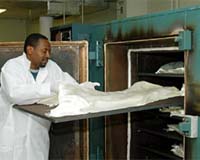| . |  |
. |
Croix-Des-Bouquets, Haiti (AFP) Jan 27, 2010 Magalee, 13, smiled sadly as she told of her punishing former life as a "restavek," one of Haiti's child slaves whose number will likely rise as poverty spreads in the wake of the killer quake. "I had to work morning, noon and night, cleaning, cooking, washing. I got up at five o'clock and worked until eight o'clock in the evening. Everybody in the family beat me," she told AFP. Haiti currently has around 450,000 restaveks, meaning "stay with" in Creole, children usually from poor rural families who send them to homes in the capital with a promise that they will do some work and be educated. Rarely do they see the inside of a school though. "The work was too hard and the family was not kind so I ran away to the police station, they were nice and sent me here," she said, referring to the Centre d'Appui au Developpement (CAD) which looks after former restaveks. The CAD home in central Port-au-Prince was annihilated in the January 12 earthquake, entombing five of Magalee's friends, all former restaveks aged eight to 16. Fortunately Magalee had already moved to CAD's large new house in a field near Croix-des-Bouquets, a few miles (kilometers) outside Port-au-Prince, which survived the tremor. "The problem of restavek will get worse because of the earthquake," said Gertrude Sejour, whose Fondation Maurice A. Sixto (FMAS) works with CAD to reduce the phenomenon. Maybe three or five out of 1,000 are well treated, she said. "If a restavek's family is killed and they survive then they will end up on the street. At the same time, many families have lost everything so more will resort to handing their children over to be restavek," she said. "Vulnerable parents means vulnerable children. And if families can't even feed their own children, they're not going to feed the restavek." At CAD, the girls -- boy restaveks are rare -- are educated and taught an activity like sewing with which they could eventually earn a living. "The number of restaveks is going to go up after the earthquake because lots of families will be in a difficult situation, there will be lots of unemployed," said CAD's president Marlene Verdier Mondesir. "Often there aren't schools in the countryside, so people go there and tell families they'll take their children to school in Port-au-Prince, but they don't get educated. They are beaten, some are raped, some get whipped." Sejour said the problem of restavek and other child laborers is "fundamental to all our problems in Haiti." "In our culture, a child that works is considered a slave and you can do anything you want, violence or anything, and so you create a brute, someone who doesn't work for good but to destroy." CAD's objective is to reunite the children with their parents, but first they must be identified and given a money-making activity so that they can provide for the child. Sejour said the key to ending the problem is to raise public awareness of the abuse and to provide education and jobs other than farming in the rural communities. "I think that this catastrophe is an opportunity," said Frank Mahotiele of the Pan-American Development Foundation. "To create jobs in the countryside, so that a child can go to school in the countryside, and to give people access to healthcare. "Lots of people are deserting Port-au-Prince to be looked after in the countryside," he said. "Some people say they're never coming back."
Share This Article With Planet Earth
Related Links Global Trade News
 US imposes stiff duties on Chinese blankets
US imposes stiff duties on Chinese blanketsWashington (AFP) Jan 27, 2010 The United States made an initial decision Wednesday to slap stiff duties - as high as 175 percent - on woven electric blankets from China on claims they were being dumped at unfairly low prices. The Commerce Department said it had "preliminarily determined" that "Chinese producers/exporters have sold woven electric blankets in the United States at 90.32 to 174.85 percent less than fair va ... read more |
|
| The content herein, unless otherwise known to be public domain, are Copyright 1995-2009 - SpaceDaily. AFP and UPI Wire Stories are copyright Agence France-Presse and United Press International. ESA Portal Reports are copyright European Space Agency. All NASA sourced material is public domain. Additional copyrights may apply in whole or part to other bona fide parties. Advertising does not imply endorsement,agreement or approval of any opinions, statements or information provided by SpaceDaily on any Web page published or hosted by SpaceDaily. Privacy Statement |